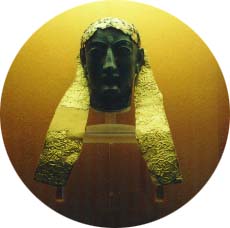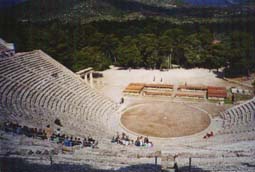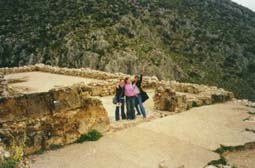Pyrrha's Roman
Pages
title page
![[group]](jmgr19.jpg)
Here is the group in the Stadium at Olympia - including, appropriately, the Head of the PE Department! This was a joint trip with the Department of Religion and Philosophy.

The Temple of Apollo at Delphi in its wonderful setting on the mountainside. The oracle of Apollo was famous in antiquity as the place where the Greeks would go to ask for prophecies. The priestess (the Pythia or Sibyl) would go into a trance to give a prophecy.

The Tholos, away from the main sanctuary of Apollo. A beautiful circular building which may have been a treasury - the Greeks would take expensive gifts for the gods.

In the museum at Delphi are the remains of what must have been impressive Chryselephantine statues : made of ivory (which has now discoloured) and gold. This one is Apollo.

These are fragments of Artemis - her head and part of an arm. The most well-known statues of this type : the Parthenos from Athens and Zeus from Olympia, have not survived.

The theatre at the sanctuary of Aesculapius at Epidauros - hard to believe that you can hear what is being said in the orchestra from the very top tier of seats!

The canal across the isthmus at Corinth.

Everyone had a 'day off' from organised sightseeing as the Greeks celebrated Independence Day. Here is part of the procession in the little town of Nafplion.
Now for some statues!



You can see that the first is the earliest - an archaic 'kore' (young woman) from the Acropolis museum in Athens. The second is the bronze Zeus (or Poseidon) of Artemisium, now in the National Archaeological Museum in Athens and the third is Hermes from Olympia, holding the infant Dionysus .

The group visited some prehistoric sites to see the buildings and artefacts associated with Homer's stories of Troy.
This is the Lion Gate at Mycenae - notice the huge lintel stone with carvings of lions rearing up towards the centre.

The top of the citadel at Mycenae! This is where king Agamemnon, the leader of the Greek expedition to Troy, is supposed to have lived.

The so-called Treasury of Atreus (the father of Agamemnon), which is really a 'beehive' tomb.

This is a bath in the citadel at Pylos, where old Nestor is supposed to have lived. It is the first time that we have included this site in a Classics Dept trip, and it was very worthwhile even though access to parts of the site was restricted.

This is the Acropolis in Athens, taken from the Hephaistion, or temple of Hephaistos. You can see how the ancient citadel rises from the modern city.

Now we are looking down from the Acropolis and can see the Hephaistion in front of the modern city.

This is the front of the Parthenon, the temple to Athene Parthenos (Athena the Maiden). From this angle you can see how the pillars slope inwards to give the illusion that they are perpendicular when seen from a distance.

This porch on the Erechtheum (in honour of the mythical founder of Athens, Erechtheus) has pillars in the form of young girls : pillars of this kind are called Caryatids.
The trip was a huge success and we are grateful to Mrs Beech for all her meticulous planning and enthusiasm.
LINKS
for Class. Civ. Epic students.
forts at The Lunt and Caerleon
an Iron Age hillfort and Cirencester museum
for my Latin and Greek GCSE students.
Easter cruise 2006
trip to Greece 2002.
Latin passages read by Classics students.
[return to top of page]
![[the real Medusa!]](mabig1.gif)